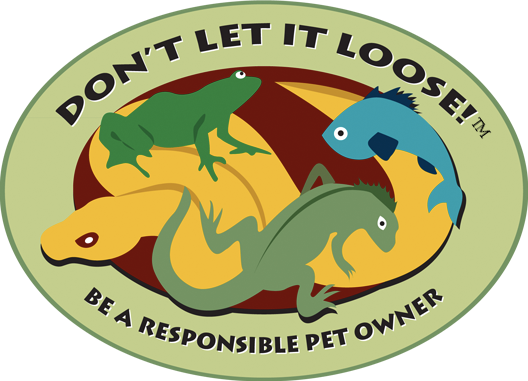Don’t Let it Loose Dodgeball is a high-energy game designed to give your students a visual representation of the impacts of invasive species on an environment. You can download and print these instructions with the link at the bottom of the page.
Objective: The purpose of this activity is to introduce students to the issue of aquarium pet release. Following this activity, students will realize some of the primary aquarium pets that can cause problems, the negative impacts they cause, and alternatives to pet release.
Background: When aquarium pets and plants are released into natural habitats they pose a significant threat to aquatic life and the food webs they support. After being released, introduced animals and plants are difficult, if not impossible, to remove, and can cause irreversible damage to food webs.
Activity Procedure for 20 students
Activity Time: 25-50 minutes (allows for 5 minutes for activity introduction)
Purpose: Teach about the issue of aquarium pet release, the problems they cause, and alternatives to not letting pets loose.
Materials: 8” buckets (6), pipe cleaners (50), ping pong balls (30), aquarium pet badges (25), native animal badges (20), orange marker flags (50), and white marker flags (50).
Introduction:
- Many aquarium pets can be enjoyable to care for in your home, but many can be harmful if released into the wild.
- Discuss examples of released pets and the consequences, such as boa constrictor snake releases in Florida, red-eared slider turtle releases, American bullfrog in the western US, and goldfish releases. Different species could be discussed depending on local issues.
- Explain that aquarium pets should never be released. Alternatives are to give your pet to a friend, family member, or contact your local pet shelter or local independent pet store.
- Discuss the harm that released pets can cause to native habitats and species.
- Discuss their impacts on food webs.
Game Play
Playing field set up ideally on an outdoor grass area: Create a square field outlined with orange flags approximately 40’x40’. In each corner create a zone (6’x6’) with white flags, this is the safe feeding zone. In the middle, create a circle pond (approximately 12’ in diameter) of white flags for the aquarium pet area. Place a bucket of 20 ping pong balls in the middle of the center aquarium pet circle. Place additional buckets with five pipe cleaners (food) apiece in each safe corner zone.
Pick two children to be aquarium pets who remain outside of the marked play square until the activity begins. Separate the rest of the children into four equal groups which represent native species and put each group in a different safety corner. Give the aquarium pet children an appropriate aquarium pet badge, and all other children receive a native species badge.
Before you introduce the aquarium pets, allow the native species to rotate clockwise between safety zones where they will collect “food” a few times to get the feel for it. Tell children to walk instead of running between the zones.
Introduce the aquarium pets into the area of play in a scenario where the activity facilitator dumps an aquarium into the pond in the center circle. Give each of the aquarium pet one ping pong ball. At this time be sure to ask the children…what are the consequences of releasing pets?” What can I do instead of dumping aquarium pets into a lake or wetland?”
Start the game. When facilitator says “feeding time”, the native species rotate clockwise to the next station. When the native species are traveling between safe zones, the aquarium pets toss ping pong balls at them FROM THE WAIST DOWN. Aquarium pets must stay in the center circle pond. Native species may try to dodge the ball. If they are hit by the ball they must come to the middle, turn in their native badge, take an aquarium pet badge and get a ping pong ball. Surviving native animals take one piece of food from the bucket. Aquarium pets collect the ping pong balls off the ground that were tossed and return them to the center bucket. The facilitator will announce “feeding time” again, and remaining native species will rotate clockwise to the next station. Once again, if hit native species come to the center and exchange their badge for an aquarium pet badge. Repeat with additional feed times.
After a couple of rotations, it will become evident that the native species are disappearing, the food is gone, and the aquarium pet populations are growing. This is a good place to reinforce how aquarium pets can have an impact and take over native habitats.
Extensions
- Prior to the facilitator visit, classroom teacher can have the kids make their own native species or aquarium pet mask for the game.
- Art: Have the kids produce a drawing of a wetland prior to aquarium pet release and after.
- Visit a wetland and have a scavenger hunt. Talk about the diversity and uniqueness of the wetland.
- Visit www.stopais.org and www.dontletitloose.com to learn more
Game set up variations
Rope, trees or other natural features of your play area could be used to define your game playing field; marker flags can be substituted. The food can be held in buckets as described or other simple receptacles can be substituted.
Click here to download this instruction sheet – DLIL dodgeball_activity_instructions_2021
